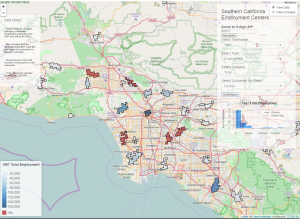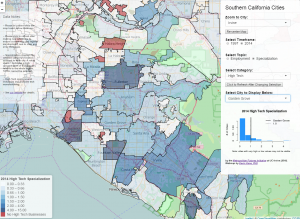Category: Detecting Job Density Over Time
Read the report on Detecting Job Density Over Time
The Los Angeles region is a classic example of a “polycentric metropolis” that is characterized by several centers of job density instead of a single, dominant downtown. This report examines how employment subcenters have been evolving since the 1990s in terms of their changing composition and spatial locations. Download the full report here.
Explore the web app on Employment Subcenters in Southern California (Job Density)
 Click here for a web mapping application that allows you to explore the changing dynamics of employment centers in Southern California. This application corresponds to MFI’s Quarterly Report “Detecting Job Density Over Time.” Note: the webmap titled, “Employment Dynamics Across Southern California Cities” presents these same data but for cities rather than subcenters.
Click here for a web mapping application that allows you to explore the changing dynamics of employment centers in Southern California. This application corresponds to MFI’s Quarterly Report “Detecting Job Density Over Time.” Note: the webmap titled, “Employment Dynamics Across Southern California Cities” presents these same data but for cities rather than subcenters.
Explore the web app on Employment Dynamics Across Southern California Cities
This web mapping application e xplores job growth and localized employment specialization at the city level in five key economic sectors: business services, retail, industry, technology, and “creative” work. Note: this webmap presents the same data as the “Employment Subcenters in Southern California” webmap, but for cities rather than subcenters.
xplores job growth and localized employment specialization at the city level in five key economic sectors: business services, retail, industry, technology, and “creative” work. Note: this webmap presents the same data as the “Employment Subcenters in Southern California” webmap, but for cities rather than subcenters.
Read published research on Detecting Job Density Over Time
Publication:
Kane, Kevin, John R. Hipp, and Jae Hong Kim. (2016). “Los Angeles employment concentration in the 21st century.” Urban Studies.
Abstract:
This paper is an empirical analysis of employment centres in the Los Angeles region from 1997 to 2014. Most extant work on employment centres focuses on identification methodology or their dynamics during a period of industrial restructuring from 1980 to 2000. We analyse employment centres using point-based, rather than census tract-based employment data and a non-parametric identification method with a single concept of proximity. We focus on changes across five key industries: knowledge-intensive business services (KIBS), retail, creative, industrial and high-tech, emphasising changes in centre composition as well as their boundaries. Results show far greater change across centres than previous longitudinal studies. Only 43% of the land area that is in an employment centre is part of one in both 1997 and 2014. Using a persistence score, centres range from stable to highly fluctuating, but emerging, persisting and dying centres are found in core and fringe areas alike. KIBS are most associated with stable centres, while high tech employment is attracted toward emerging areas and retail exists throughout. Emerging centres are more likely to have greater accessibility, while industrial employment becomes far more concentrated in centres by 2014.